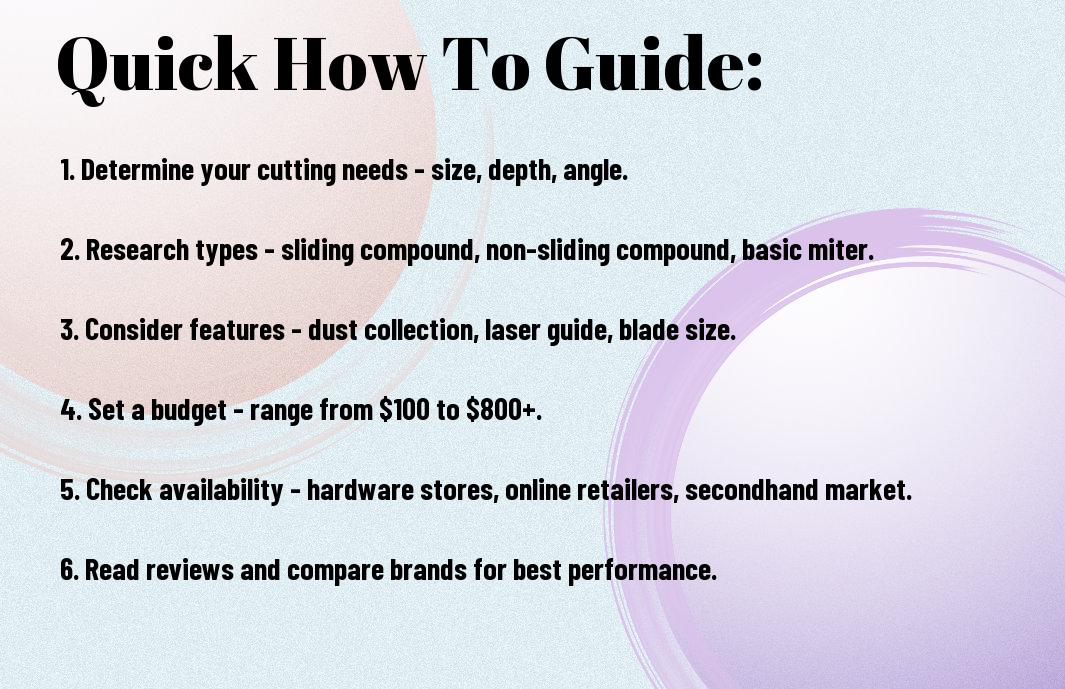How to Find the Right Miter Saw
Right tool can make all the difference in your woodworking projects, and finding the right miter saw is vital for precision and efficiency. Consider blade size, power, and features like adjustable angles and laser guides. Whether you are a beginner or a seasoned carpenter, selecting the best miter saw can impact the quality of your cuts. Follow these tips to ensure you choose the perfect miter saw for your needs.
Contents
Understanding Your Needs
Determining Your Budget
A miter saw can range in price from budget-friendly options to high-end professional models. While it is important to set a budget that suits your needs, it is also crucial to consider the quality and features you require for your projects.
Identifying Your Project Requirements
Now, before purchasing a miter saw, consider the types of projects you will be working on. Are you a hobbyist working on small DIY projects or a professional carpenter taking on large-scale constructions? Project requirements dictate the size, cutting capacity, and additional features you may need in a miter saw.

Key Features to Consider
Assuming you are in the market for a miter saw, here are some key features to consider before making your purchase:
- Blade Size and Type
- Motor Power and Speed
- Bevel and Miter Capacity
- Dust Collection System
Though there are other features to take into account, focusing on these will ensure you find a miter saw that meets your needs.
Blade Size and Type
Now, when selecting a miter saw, consider the blade size and type that will best suit your cutting needs. The larger the blade, the deeper and wider the cut it can make. Choose the blade type based on the materials you will be working with most frequently.
Motor Power and Speed
Motor power and speed play a crucial role in the performance of a miter saw. A high motor power paired with variable speed settings allows for smoother and more accurate cuts. Plus, a powerful motor can handle tougher materials and larger workpieces with ease.
Bevel and Miter Capacity
An important feature to look for in a miter saw is the bevel and miter capacity. Ensure that the saw offers enough flexibility in adjusting both bevel and miter angles to accommodate various cutting requirements. Size up this feature according to the types of projects you plan to undertake.
Dust Collection System
Clearly, a dust collection system is crucial for maintaining a clean and safe work environment. A miter saw with an efficient dust collection system will help keep your workspace free of debris and improve visibility while cutting. Miter saws with strong dust collection capabilities are a wise choice for indoor workshops.
Tips for Choosing the Right Miter Saw
Your choice of a miter saw can significantly impact the quality of your woodworking projects. Consider the following tips to ensure you pick the right one for your needs.
Considering the Weight and Portability
Choosing a miter saw that is easy to move around can make a big difference, especially if you work on projects in different locations. Look for a saw that strikes the right balance between sturdiness and portability.
Looking for Additional Features
An ideal miter saw should come equipped with features that enhance accuracy and efficiency. Features like laser guides, dust collection systems, and ergonomic handles can make your woodworking tasks smoother and more precise.
Additional features such as a sliding arm or a crown molding stop can also add versatility to your miter saw, allowing you to tackle a wider range of projects.
Reading Reviews and Ratings
With countless miter saw options on the market, it can be challenging to make the right choice. Reading reviews and ratings from other users can provide valuable insights into the performance, durability, and overall satisfaction with the saw.
Plus, reviews can alert you to any potential issues or drawbacks that may not be apparent from the manufacturer’s description, helping you make a more informed decision.
Factors Affecting Accuracy and Precision
Now, when it comes to choosing the right miter saw for your woodworking projects, accuracy and precision are crucial factors to consider. These elements can make a significant difference in the quality of your cuts and the overall success of your project.
- Fence System and Alignment:
Clearly, a properly aligned fence system is vital for accurate and precise cuts. Make sure the miter saw you choose has a sturdy fence that is easy to adjust and stays true to the cutting blade.
- Laser Guide and LED Lights:
Precision laser guides and LED lights help improve accuracy by providing a visual guide for your cuts. They can help you align your material correctly and make precise cuts with ease.
- Detent System and Positive Stops:
One of the key features to look for in a miter saw is a reliable detent system with positive stops. This system allows you to easily set common angles for your cuts, ensuring consistency and accuracy in your work.
After considering these factors, you can make an informed decision and choose a miter saw that will meet your accuracy and precision needs for your woodworking projects.
Safety Features to Look For
Blade Guard and Safety Switch
Despite what some may think, the blade guard and safety switch are crucial safety features to look for in a miter saw. Some models come with a transparent blade guard that allows for better visibility while cutting, and a safety switch that prevents accidental starts.
Electric Brake and Soft-Start
If you want added safety features, consider miter saws with an electric brake and soft-start function. If the blade stops almost immediately upon releasing the trigger, it reduces the chance of accidents. The soft-start feature, on the other hand, gradually increases the blade’s speed to prevent jerky movements.
Switching blades can also be safer and more convenient with an electric brake, as it stops the blade quickly for efficient blade changes.
Kickback Prevention System
Electric miter saws with a kickback prevention system are a must-have for safety conscious users. Another important feature, it helps reduce the risk of the workpiece being ejected towards the user during a cut. This system can prevent serious injuries and keep you safe while operating the miter saw.
Popular Types of Miter Saws
Once again, when it comes to choosing the right miter saw, it’s important to understand the different types available. Here are some of the most popular types:
| Compound Miter Saws | Sliding Compound Miter Saws |
| Dual-Bevel Miter Saws |
Compound Miter Saws
Little in size but big in functionality, Compound Miter Saws allow you to make bevel cuts in addition to regular miter cuts. They are great for projects that involve cutting angles on two planes.
Sliding Compound Miter Saws
You can benefit greatly from Sliding Compound Miter Saws when working with wider boards or materials. The sliding feature allows you to move the blade back and forth, increasing the cutting capacity of the saw.
To take advantage of the sliding capability, you need to pull the saw towards you as you lower the blade onto the material you are cutting.
Dual-Bevel Miter Saws
To achieve precise angle cuts on both the left and right sides without having to flip the material, a Dual-Bevel Miter Saw is the way to go. This type of saw is ideal for projects that require intricate cuts on both sides of the material.
When using a dual-bevel miter saw, you can easily tilt the blade to the left or right to make bevel cuts, saving you time and effort in adjusting the material for each cut.
Summing up
Conclusively, finding the right miter saw involves considering the types of cuts needed, the power and features required, as well as the workspace available. By determining these factors, you can select a miter saw that best suits your needs and helps you achieve accurate and efficient results in your woodworking projects.



